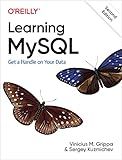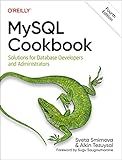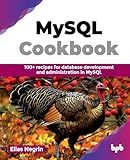Best Database Management Books to Buy in December 2025

MySQL Crash Course: A Hands-on Introduction to Database Development



Learning MySQL: Get a Handle on Your Data



MySQL Cookbook: Solutions for Database Developers and Administrators



MySQL Cookbook: 100+ recipes for database development and administration in MySQL (English Edition)



Murach's MySQL (4th Edition)



MySQL Cookbook: Solutions for Database Developers and Administrators


To insert data into a MySQL table, you can use the INSERT INTO statement. Here is an example of the syntax:
INSERT INTO table_name (column1, column2, column3, ...) VALUES (value1, value2, value3, ...);
Here, table_name is the name of the table in which you want to insert the data. column1, column2, column3, etc. represent the column names of the table where you want to insert data. value1, value2, value3, etc. are the corresponding values that you want to insert into those columns.
For instance, if you have a table named "customers" with columns "name", "email", and "age", here's how you would insert a new row of data:
INSERT INTO customers (name, email, age) VALUES ('John Doe', 'john.doe@example.com', 25);
Note that string values like names and emails need to be enclosed in single quotes ('').
You can also insert data into specific columns by specifying the column names:
INSERT INTO customers (name, age) VALUES ('Jane Smith', 30);
In this example, because we only specified the "name" and "age" columns, the "email" column would be left empty.
That's how you can insert data into a MySQL table using the INSERT INTO statement.
How to insert data into a MySQL table using Python?
To insert data into a MySQL table using Python, follow these steps:
- Install the mysql-connector-python package by running the following command in your terminal: pip install mysql-connector-python
- Import the MySQL Connector module in your Python code: import mysql.connector
- Establish a connection to the MySQL database by creating a connection object and specifying the host, user, password, and database: mydb = mysql.connector.connect( host="localhost", user="yourusername", password="yourpassword", database="yourdatabase" )
- Create a cursor object to execute SQL commands: mycursor = mydb.cursor()
- Write an INSERT statement to insert data into the table. For example, to insert data into a table named "customers" with columns "name" and "email": sql = "INSERT INTO customers (name, email) VALUES (%s, %s)"
- Execute the INSERT statement by passing the values as a tuple to the execute() method of the cursor object. For example, to insert the values "John Doe" and "johndoe@email.com": values = ("John Doe", "johndoe@email.com") mycursor.execute(sql, values)
- Finally, commit the changes to the database: mydb.commit()
That's it! You have successfully inserted data into a MySQL table using Python. Remember to close the connection when you are done:
mydb.close()
Note: Make sure you replace "localhost", "yourusername", "yourpassword", "yourdatabase", "customers", and the column names according to your MySQL server configuration.
What is the syntax for inserting data into a MySQL table?
The syntax for inserting data into a MySQL table is as follows:
INSERT INTO table_name (column1, column2, column3, ...) VALUES (value1, value2, value3, ...);
Here, table_name refers to the name of the table into which you want to insert data. column1, column2, column3, ... refers to the names of the columns in the table where you want to insert data. value1, value2, value3, ... refers to the actual values you want to insert into the corresponding columns.
Note: The number of columns and values must match, and the order of columns and values must be the same.
How to insert data into a MySQL table using PHP?
To insert data into a MySQL table using PHP, you can follow these steps:
- Establish a connection to your MySQL database. You can use the mysqli_connect() or PDO functions to create a connection object.
// Using mysqli_connect() $connection = mysqli_connect("host", "username", "password", "database");
// Using PDO $connection = new PDO("mysql:host=host;dbname=database", "username", "password");
- Create an SQL INSERT statement with the data you want to insert. Make sure to use placeholders (? or :placeholder) instead of directly concatenating the values.
// Using mysqli (Procedural) $sql = "INSERT INTO table_name (column1, column2, column3) VALUES (?, ?, ?)"; $stmt = mysqli_prepare($connection, $sql); mysqli_stmt_bind_param($stmt, "sss", $value1, $value2, $value3); mysqli_stmt_execute($stmt);
// Using PDO $sql = "INSERT INTO table_name (column1, column2, column3) VALUES (:value1, :value2, :value3)"; $stmt = $connection->prepare($sql); $stmt->bindParam(':value1', $value1); $stmt->bindParam(':value2', $value2); $stmt->bindParam(':value3', $value3); $stmt->execute();
- Bind the values to the prepared statement placeholders using mysqli_stmt_bind_param() or bindParam().
- Execute the prepared statement using mysqli_stmt_execute() or execute().
You can repeat these steps for each set of data you want to insert. Remember to close the connection after you finish inserting the data.
// Using mysqli mysqli_close($connection);
// Using PDO $connection = null;
Note: Ensure that you have the necessary permissions to perform the insert operation on the MySQL table.
How to insert HTML content into a MySQL table?
To insert HTML content into a MySQL table, you can follow these steps:
- Create a table: Begin by creating a table in MySQL that will store HTML content. For example, you can use the following SQL query to create a table named html_table with a column named content:
CREATE TABLE html_table ( id INT AUTO_INCREMENT PRIMARY KEY, content LONGTEXT );
- Prepare the HTML content: Prepare the HTML content that you want to insert into the table. Make sure to properly escape the content to prevent any SQL injection vulnerabilities. For example, if you are using PHP, you can use the mysqli_real_escape_string function to escape the content.
$htmlContent = mysqli_real_escape_string($connection, $htmlContent);
- Insert HTML content: Use the INSERT statement to insert the HTML content into the table. For example, if you are using PHP and have a connection established, you can use the following code:
$query = "INSERT INTO html_table (content) VALUES ('$htmlContent')"; mysqli_query($connection, $query);
- Execute the query: Execute the query to insert the HTML content into the MySQL table. Make sure to handle any errors that may occur during the execution.
That's it! The HTML content should now be inserted into the table. Make sure to adjust the query and code based on your specific programming language and requirements.
How to insert data into a MySQL table from a form using AJAX?
To insert data into a MySQL table from a form using AJAX, you can follow these steps:
- Create a form in HTML with input fields corresponding to the columns in your MySQL table.
- Add an event listener to the form's submit event to handle the AJAX request when the form is submitted.
document.getElementById("myForm").addEventListener("submit", function(event) { event.preventDefault(); // Prevent form from submitting traditionally sendData(); });
- Write a JavaScript function (sendData) to handle the AJAX request and send the form data to a server-side PHP script.
function sendData() { var xmlhttp = new XMLHttpRequest(); var url = "insert.php"; // Replace "insert.php" with the path to your server-side script
xmlhttp.onreadystatechange = function() { if (this.readyState === 4 && this.status === 200) { // Handle the server response here (if needed) alert(this.responseText); } };
xmlhttp.open("POST", url, true); xmlhttp.setRequestHeader("Content-type", "application/x-www-form-urlencoded"); xmlhttp.send(new FormData(document.getElementById("myForm"))); }
- Create a back-end server-side script (e.g., insert.php) to handle the AJAX request and insert the data into the MySQL table.
Make sure to replace your_username, your_password, your_database, your_table_name with your own values.
- When the form is submitted, the JavaScript function sendData will be called, which will initiate the AJAX request to the server-side script insert.php. The server-side script will then insert the form data into the MySQL table.
Note: Ensure that your server environment supports PHP and MySQL, and that you have the necessary permissions to access the MySQL database.
How to insert data into a MySQL table and get the generated auto-increment ID?
To insert data into a MySQL table and retrieve the generated auto-increment ID, you can follow these steps:
Step 1: Connect to the MySQL database. Before inserting data, establish a connection to the MySQL database using any programming language or a MySQL client like MySQL Workbench.
Step 2: Execute an INSERT statement. Execute an INSERT statement to add a new row to the table. Make sure to exclude the auto-increment column from the query, as the database will automatically generate the ID.
Example:
INSERT INTO table_name (column1, column2) VALUES ('value1', 'value2');
Replace table_name with the actual name of the table and column1, column2, value1, value2 with specific column names and values.
Step 3: Retrieve the last generated ID. After executing the INSERT statement, retrieve the last generated ID using the appropriate function provided by your programming language or MySQL client.
In most cases, the function is called last_insert_id().
Example (using Python with MySQL Connector):
import mysql.connector
Establish a connection
cnx = mysql.connector.connect(user='user', password='password', host='localhost', database='database_name')
Create a cursor
cursor = cnx.cursor()
Execute INSERT statement
query = "INSERT INTO table_name (column1, column2) VALUES (%s, %s)" values = ('value1', 'value2') cursor.execute(query, values)
Retrieve the last generated ID
last_id = cursor.lastrowid print("Last inserted ID:", last_id)
Commit the changes
cnx.commit()
Close the cursor and connection
cursor.close() cnx.close()
Replace 'user', 'password', 'localhost', 'database_name', table_name, column1, column2, value1, value2 with appropriate values.
Step 4: Commit the changes and close the connection. After retrieving the last generated ID, commit the changes to the database to make it permanent. Finally, close the cursor and connection to release resources.
Note: The exact method for retrieving the last generated ID may vary depending on the programming language and database connector you are using. Consult the documentation or examples specific to your setup.
